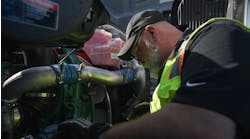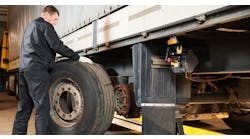In could be said that by incorporating GPS and telematics ( the blending of computers and wireless telecommunications) technologies into a fleet, managers can “ride along” with their vehicles. This provides real-time information which can be used to make more intelligent business and fleet management decisions.
Among the typical benefits of GPS and telematics: reduced fuel consumption and emissions; lower fleet operating and maintenance costs; extended vehicle lifecycles; improved fleet productivity; and increased safety.
To get some insight into how these technologies can be leveraged, Fleet Maintenance reached out to several providers of these types of systems.
Part 1
How investing in telematics pays off
By Chris Ransom, Director of Sales Engineering, Verizon Networkfleet
Telematics, which includes GPS vehicle tracking systems, provides public and private fleets with a powerful tool to help cut costs and allow vehicle fleets to operate more efficiently. Changes in fleet usage patterns based on vehicle telematics may result in cost savings that, along with improvements in productivity, can help you to easily justify the investment.
A GPS vehicle tracking system gives you the precise location and performance of every telematics-equipped vehicle and asset in your fleet. With this information, you can take steps to:
- Optimize scheduling, routing and vehicle utilization to reduce inefficiencies.
- Streamline maintenance processes and reduce administrative overhead.
- Reduce fuel usage and emissions as well as improve driver safety.
Achieving these results starts with implementing a telematics system that includes both GPS vehicle tracking and engine diagnostics. Productivity can be further enhanced with the addition of asset tracking capabilities. Once in place, this system provides the data you need to make informed management decisions.
IMPROVE EQUIPMENT UTILIZATION
Telematics systems offer a variety of detailed reports that track vehicle and driver activity. By reviewing these reports regularly, you gain insights into short- and long-term driving patterns and equipment utilization that can impact productivity. This helps you to identify problem areas and take action to use your vehicles and drivers more efficiently.
For example, some reports show the details of each trip a vehicle makes during a specified time period. Fleet utilization reports also provide a summary of overall fleet activity, indicating if trips are increasing or decreasing over time. By simultaneously tracking trips and miles, you can make informed decisions about optimizing vehicle usage.
These same reports are available for use in asset tracking. Trying to locate mobile assets in the field can be a huge time-waster, especially if your agency frequently moves assets such as generators or trailers. GPS systems that include a mobile asset tracker can save time while reducing administrative headaches.
VEHICLE ROUTING
Improving routing, even by a small percentage, can increase the overall productivity of your fleet. It also can help to lower fuel usage and vehicle emissions. Improved routing can result in workers performing more jobs each day, thereby improving productivity. What’s more, dispatchers spend less time calling drivers to find out where they are.
Many telematics customers find that the result is faster, more efficient work schedules, leading to greater customer satisfaction.
A GPS fleet tracking system can automatically determine the closest vehicle to a given job site, or any location on the map, and provide turn-by-turn directions to the selected destination. In addition, many systems offer Garmin integration, which lets you communicate job assignments directly to the driver in the vehicle.
Improved dispatching and better routing can allow you to take on more jobs without adding vehicles or personnel. It also may allow you to group multiple jobs within the same vicinity in a particular time period rather than sending employees from one side of town to another.
STREAMLINED TASKS
Nothing wastes time more than a vehicle stalled on the roadside in need of repair. A GPS vehicle tracking system with engine diagnostics can help you take steps to prevent vehicle breakdowns in several ways.
First, you can receive advance warning of engine trouble through alerts, allowing you to fix minor problems before they become larger ones. Secondly, you can set proactive reminders for oil changes, tune-ups and other preventive maintenance activities to keep vehicles in top condition.
When using a telematics solution to manage the preventive maintenance process, the majority of vehicle repair work will likely shift to scheduled maintenance, helping to diminish emergency and unexpected repairs and prevent breakdowns.
If you maintain and service your own vehicles, you also may notice that labor costs can decrease as vehicle breakdowns and unexpected repairs decline.
FUEL AND SAFETY
Telematics can help you manage and reduce fuel consumption by providing you with needed information to take steps to reduce speeding and idle time, improve routing, lower miles driven and monitor miles per gallon. When combined with your internal business policies and goals, telematics is a powerful ally in the fight against high fuel costs.
At the same time, using telematics data to take steps to reduce speeding can improve driver safety.
Finally, telematics can help transform your organization by providing tools to manage your entire fleet more effectively. Using telematics data to modify fleet usage and driver behavior can result in the rapid return of your initial investment in the form of reduced expenses and higher productivity.
Chris Ransom is the director of sales engineering for Verizon Networkfleet, (www.networkfleet.com), a provider of reliable and comprehensive GPS tracking of vehicles and assets. In this role, he is responsible for working with commercial and public fleets to integrate telematics technology into their operations and maximize the benefits of improved efficiencies.
Part 2
GPS: Key to driving down costs while increasing service
By Laura Lohrke, Product Manager, Roadnet Technologies
For years, consumer technology has greatly impacted our expectations of business applications. GPS, a hot-button topic in the transportation industry, is a great example.
With the introduction of consumer navigation systems followed by the explosion of smartphones, the expectations for GPS have grown significantly.
However, you may have noticed that consumer technology often moves faster than business technology. Why is this? One reason is because consumer technology only has to be somewhat accurate in order to be successful. On the other hand, business-to-business solutions have to be spot-on for widespread adoption.
Today, as GPS technology is becoming more readily integrated by businesses of all sizes, questions of cost and true value arise. Are the costs of new technology worth it? Will customers move to competitors if we don’t adapt?
A BALANCE
There is a cost to implement and maintain mobile technologies with GPS, but when you strike a balance between cost and efficiency, the benefits and return on investment of implementation outweigh the cost.
The gains of GPS extend far beyond answering the question: “Where is my resource?” GPS provides insight for fleet managers to become more nimble – adjusting operating procedures to decrease mileage and windshield time, reduce fuel costs, increase safety and manage driver behaviors while improving customer service.
IoT
Ever hear the term Internet of Things (IoT)? When we talk about IoT in regard to fleet management, “things” are vehicles and the people who drive them.
GPS technology and mobile applications provide transportation managers the ability to control the “things” remotely. This means real-time benefits that include enhanced vehicle and driver monitoring and managing from afar, as well as tracking workload efficiency and productivity of remote employees.
With GPS technology, fleet managers can now answer key questions, such as this one: “Are drivers following the plan or driving extra miles?” This is an important question, as decreased miles with less windshield time and less fuel means lower costs.
OBD-II
Mileage and windshield time are not the only factors impacting fuel savings. Telematics pulling data through the Onboard Diagnostics Port (OBD-II) is key.
Engine idling can be low-hanging fruit on the fuel savings spectrum. One gallon of fuel is consumed for each hour of idling. For example, if you’re running an eight-hour route – where 20 percent of the route is spent driving and 80 percent is spent servicing the customer, on average, half of the service time is spent idling. That’s $2,500 a year in fuel per truck going out the tailpipe.
With this information at your fingertips, you can take steps to correct driver behavior and help drive down fuel costs.
Additional behavior monitoring that telematics factors is speeding, harsh breaking, harsh cornering events and more. Event alert exceptions can pinpoint potential issues that could negatively impact safety and costs.
MEASURABLE FEEDBACK
A driver’s behavior is more than just operating a vehicle. According to the National Private Truck Council, more than one-third of a driver’s day is spent in non-driving functions.
If you are operating a fleet without a mobile device, you don’t have measurable feedback. You’re flying blind, hoping that drivers take your truck, handle it properly and deliver the correct goods on time.
Capturing events from a mobile app provides a great deal of insight into your business. It aids in the invoice process through proof of delivery functions (signature capture, customer acknowledgement and quantities delivered), plus provides workflow guidance.
Over time, use of mobile technology offers historical data that can improve future planning and help predict future events.
WASTED MILES
With planning kept in mind, how did the route compare to what was planned? How many unplanned stops were made?
An essential component of transportation savings is efficient and strategic plans to minimize wasted miles and stops. Collecting real-time data against the original plan, via GPS tools, helps you react to customer service issues, as well as improve plans.
A good motto to follow is: Plan the work and work the plan. Otherwise, you might be missing a golden opportunity for improvement.
CUSTOMERS
Lastly, customers are king. GPS mobile technologies provide tools to constantly solve customer challenges. By using real-time data, you can offer automated communication, keep customers up-to-date and reinforce your dedication to their business.
Communicating accurate ETAs, delays and “delivery complete” messages in real time can help satisfy customers.
In conclusion, yes, the cost of new technology is worth it, and yes, customers may consider competitors if you don’t adapt.
But today, GPS tools for the trucking industry are precise, trustworthy, cost-effective and able to dramatically improve operations. With mobile GPS technology, fleet managers have more visibility into the supply chain, allowing them to streamline operations, increase safety and better service clients.
Laura Lohrke is product manager for Roadnet Technologies (www.roadnet.com), a worldwide provider of fleet and mobile management software and GPS tracking solutions for vehicles in a broad range of industries. It is a subsidiary of Omnitracs (www.omnitracs.com), a provider of fleet management, routing and predictive analytics solutions for private and for-hire fleets.
Part 3
Lowering fuel and maintenance costs with GPS fleet tracking
By Wyn Partington, Vice President of Marketing, NexTraq
Fuel and maintenance are necessary costs for any field service business. The challenge, however, comes with managing these costs when prices are constantly fluctuating.
To help keep operating expenses down, fleets are turning to solutions such as GPS fleet tracking technology. This technology is designed to not only reduce costs but maximize fleet efficiency.
While many realize the impact of driver behavior, it can be difficult to monitor and measure. Excessive vehicle idling, for example, is a major fuel-waster that can easily go unnoticed.
GPS fleet tracking technology solves this problem by gathering all data associated with behaviors, such as vehicle idling. Using just a computer or mobile device, fleets can instantly access this data and take action.
MONITORING
Idle alerts and reports can be used to determine if idling is an issue and if so, how much of an impact it’s having on a company’s bottom line.
With idle alerts, fleet managers can receive instant notification via email if any vehicle exceeds a user-defined idle limit. Idle reports allow management to view detailed information about a single vehicle or entire fleet.
Monitoring and reducing excessive vehicle idling not only cuts fuel spending significantly, it helps to lessen the spread of harmful carbon emissions.
In addition, routing plays a major role in fuel usage. Providing drivers with efficient routes can make a world of difference when it comes to reducing fuel costs. Less time driving means less fuel consumed.
If drivers have multiple stops in a day, they can use a GPS fleet tracking solution to order those stops and create the shortest, most efficient routes. Fleet management solutions also can re-route drivers on the fly if they get lost or stuck in traffic, lowering mileage and improving response times.
TRACKING
Having an effective way to manage and keep track of fuel and maintenance purchases is also key to keeping operating costs down.
Companies that have fuel cards can integrate all fuel and maintenance purchase data into a GPS fleet tracking solution and view it on one screen. This eliminates the time-consuming process of sorting through receipts and transaction data. Automated fuel reports allow fleet managers to monitor fuel efficiency and slippage and streamline the IFTA Fuel Tax reporting process.
Utilizing a fleet management solution with a fuel card integration feature also allows fleet managers or dispatchers to view member gas stations, maintenance centers and merchants directly on the platform. Dispatchers can easily locate these merchants and quickly direct drivers to the closest service stations through a Garmin personal navigation device.
This adds an extra level of convenience and saves time for both dispatchers and drivers. Additionally, many in-network stations provide discounts for greater fuel savings.
DRIVING
Aggressive driving is a behavior that can affect many areas of a business. It’s not only dangerous, it drains fuel and increases vehicle wear and tear. Habits such as excessive speeding and rapid acceleration can add stress and damage to vehicle performance more quickly, decreasing useful life.
With a GPS fleet tracking solution, fleet managers can monitor aggressive driving and generate safety reports that rank drivers based on their performance. This allows management to provide the appropriate training and coaching to improve driving habits, fuel economy and vehicle life.
SERVICE HISTORY
Another way to extend vehicle life and reduce maintenance costs is to keep track of each vehicle’s service history and ensure all vehicles receive proper routine maintenance.
Having detailed information of services performed can help to keep maintenance on schedule and reduce costly repairs down the line. Collecting and monitoring this data, however, can be a time consuming task. To simplify the process, fleet managers can utilize automated maintenance schedules, logs and reports.
Automated maintenance schedules can be set up to alert fleets when it’s time for upkeep or repairs. This confirms preventive maintenance is occurring consistently and on schedule.
Maintenance logs provide details of all services performed, helping to ensure maintenance policies are followed correctly. With maintenance reports, fleet managers can customize and generate the data they need for a complete picture of their fleet. Being able to automate this process makes it easier to monitor and track maintenance, which in turn, leads to healthier vehicles and lower repair costs.
SAVINGS
Utilizing a GPS fleet tracking solution can help companies operate at their full potential while keeping operating costs at a minimum. Companies that implement fleet management technology typically see a 10 to 20 percent reduction in fuel costs and savings of up to $35 per day, per vehicle.
Having a solution that helps better manage fleet-related expenses provides fleets with peace of mind.
Wyn Partington is vice president of marketing at NexTraq (www.nextraq.com). The company provides a cloud-based GPS fleet tracking solution that enables service and distribution businesses to optimize fleet operations while reducing operational costs and maximizing revenue.



